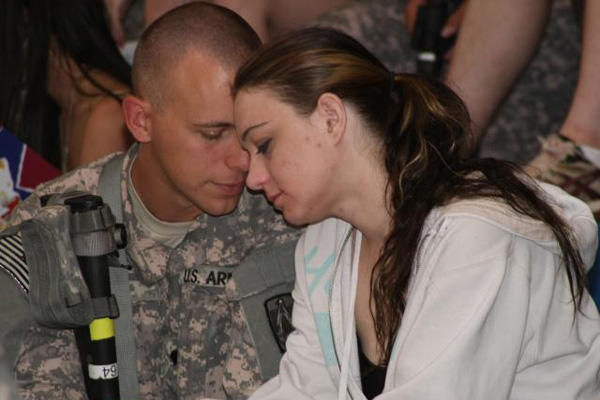Long marriage in the military is not the opposite of divorce. Yet we study the divorce rate among couples married less than five years as if that explained everything.
When researchers do consider long-married military couples, they note that the divorce rate declines as couples become more senior. They hypothesize that those military couples who stay together are “less stressed” and “better suited to the lifestyle.”
What does that mean exactly? Less stressed? Better suited?
The commissary is full of couples who have been married 20, 40, 60 years. How did those couples get through their years of PCS moves and deployment and war without giving up on each other?
That’s why I set out to study long-married military couples for my thesis. More than 1,200 active-duty Army, Navy, Air Force, Marine Corps and Coast Guard members and their spouses married more than 15 years took my online survey about long-married military couples.
They answered questions about some of the factors we know contribute to marital duration, such as age at marriage, race and education.
Then they answered questions about how they divided the responsibilities of the family. I asked how they viewed their own work and how they viewed their spouse’s job.
Since surveys can tell you a lot about what people are doing but not how or why they are doing it, I went back and completed extensive interviews with Army and Navy couples.
Here are some of the things I found out about long-married military couples with a male service member and a female civilian spouse in my research. (Please note: Female service members and dual military couples were not included in this study because a representative sample was not available at this time.)
They married too young and moved too often.
Age at first marriage is an established predictor of whether or not a couple will divorce in the civilian world. The younger you are when you marry, the more likely you are to divorce.
The average age of first marriage of those in this study was 22. That’s young. That’s about four years younger than the national average at the time these couples married.
These couples also moved an average of 8.6 times in 20 years of marriage, which is about normal for military life and more than twice as high as the civilian rate of moves.
In my line of work, I often see military professionals and command team members throw up their hands at all the young marriages around them. Maybe it would be more helpful to understand that young marriage is a hallmark of long military marriage, too.
Young marriage may just go along with being the kind of person who is more ready to commit to an organization (like the military) at a young age. It could also mean that young marriage is such an ingrained part of military life that there are still institutional supports for marriage.
This doesn’t mean young couples should run to the altar just yet. We have to know that young marriage and a young divorce can lead service members out of the military.
Remember, those surveyed were only the ones who sustained long marriage and long military service at the same time.
These young people married and then behaved themselves into a long marriage. Of all the things I researched, the two that made the most difference were the way the servicemember came to view his career and the way the spouse structured the homefront.
The servicemember thought of the military as more than a paycheck.
No matter what brought the servicemember into the military, by the time they had been married 15 years, officers and enlisted in this study were committed to the military for the duration.
Part of that commitment was due to retirement pay. Among those interviewed, the promise of a retirement income kept them deploying, moving and taking jobs with more responsibility.
Military members also had a sustained pattern of achievement. They kept getting promoted.
In part, this is due to career fit. The majority of service members in the survey indicated that they thought of their work as more than just a job. In the parlance of work orientation, they indicated that they thought of their work in the military as a “calling” or a “career/calling”-- a meaningful, socially valuable part of the servicemember’s identity that also provided financial gain and career advancement.
That kind of job satisfaction had an effect on the home, too. Marital satisfaction among those couples who thought of the military as a “job” was significantly lower than those who thought of the military as a “career” or “calling.”
In interviews, spouse after spouse said that their life in the military was worth it because of how much their husband “loved” his job or how he “didn’t want to be anything else.”
Identifying with the job and having a spouse who understood that was a central characteristic of these long-married military couples.
The spouse creates “normal.”
The thing that surprised my thesis committee (but did not surprise me at all) was how these long-married military families were constructed around separation.
Service members were training for a deployment, deploying or returning from deployment all the time. That profoundly affects family life.
Because the service member was expected to be absent for long periods, the responsibility for the structure of family life was thrust on the spouse.
By the time the couple had been married 15 years, the spouse was the one who envisioned “normal” for the family. She created it. She maintained it. She brought the service member into it.
This was not because she was a woman or because her job was less important. The military spouse created the structure of the family because she was most consistently present.
What was interesting to me was the way the long-married military husbands had a respect for this structure or routine of family life. They counted on it as the bedrock of their family.
Especially among service members who had been in combat, these men told me the structure of their family would continue “no matter what happens.”
We tell military spouses to keep everything as normal as possible during deployment. It may benefit the couple to think of “normal” as a structure the spouse creates, not just something that happens automatically.
Housework and childcare bring men back to the family.
Another factor in the success of these long-married families was providing a way for the service member to get back into the family structure after a deployment.
Over and over, I heard how service members got back into their place through housework and childcare. Dads would come home from deployment and go back to driving kids to school or sports. They supervised bedtime routines. They did laundry (the chore mentioned most often) or vacuumed or cleaned up the kitchen after dinner.
They didn’t do these chores perfectly or even the way their wives would have done it. Their wives saw the service member’s contribution as valuable and as a signal that they wanted back into the family.
That’s a trick more deploying service members need to know.
Long military marriages do not happen by accident. There are layers of behaviors and decisions that go into navigating separations, PCS moves, child rearing and career choices. The more we know about long-married military couples, the more we may be able to help young couples get from here to there.
Keep Up with the Ins and Outs of Military Life
For the latest military news and tips on military family benefits and more, subscribe to Military.com and have the information you need delivered directly to your inbox.






















